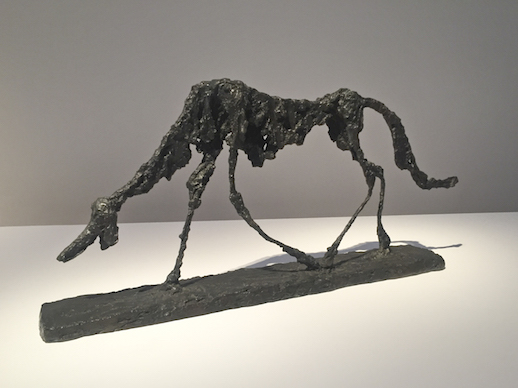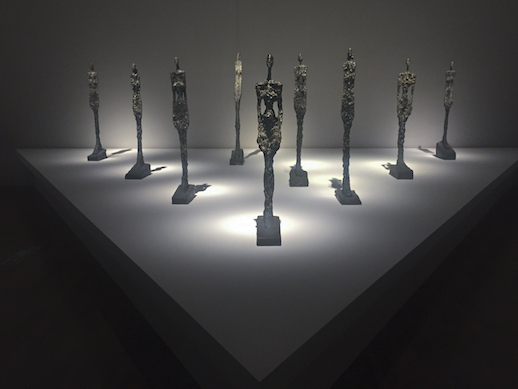Walking On
No artist captured the human condition within the context of World War II like Alberto Giacometti (1901-1966). His skinny statues of men with elongated noses and sunken eyes simultaneously represent the living and the dead, figures stuck in purgatory with permanently shell-shocked gazes. Giacometti’s work can currently be seen in a retrospective at The National Art Center, Tokyo.

Chronologically, “Alberto Giacometti: Collection Fondation Marguerite et Aimé Maeght” begins with the artist’s early Cubist and Surrealist works. From the mid-1920s Giacometti began to explore these two schools, interests he carried on through 1933, the year his father died. His ideas were as fresh as Man Ray’s or Duchamp’s, yet unlike them he continued to work from a representational basis, mixing in Cubist – even ethnographic – forms that created a degree of mutually enriching tension between artistic possibilities.
The exhibit for its part doesn’t give this early period too much attention, which is unfortunate. So many of Giacometti’s ideas later seen in his mature style emerged during this era. Take, for instance, the Surrealistic distortion of human and animal forms. The beginning of Giacometti’s elongated figures began right after this period leading up to the war, marking a return to an early ambition instilled in him by his father to depict things as they appear. Still, the influence of his Surrealist period is evident in the distorted dimensions.
Throughout, the exhibition does a perfect job of showing the progression from smaller standing figurines to groups of statues based on live street sketches. Giacometti possessed an almost-photographic capacity to observe people walking by and quickly sketch. (Later he would become more direct and have models come to his studio for more intense observation, a change signaling growing confidence in depicting things as they actually look.) By demonstrating the aesthetic transfer from 2-D to 3-D, the sketches form a key component of the exhibition. A project for Chase Manhattan Bank that Giacometti later abandoned is also featured, and the show ends on a somber note with 150 of Giacometti’s final lithographs made in Paris. Anyone wanting to become acquainted with his life’s work will be pleased, as will long-time fans afforded a chance to see the bulk of his work in person.

The show does suffer from a common pitfall of exhibitions here in Japan, however. The middle of the retrospective breaks off on a tangent and discusses his relationship with Isaku Yanaihara. If you are asking who that is, you would be correct. He was a philosopher who, according to the exhibition, greatly inspired Giacometti. Displays of Yanaihara’s art roughly in the center of the show come off as forced. Japanese museums every now and then will correlate – no matter how minor – a national figure to the artist featured. Does the Japanese public really need this to appreciate the art, or even its own identity?
Aside from this derailment, the retrospective is satisfyingly thorough. The emphasis on the often-overlooked sculpture The Dog, Giacometti’s magnum opus favoring an elongated human-like stride, is a strong choice. In context of the time, the master-less dog is open to existential interpretation and is at once an image of a hopeless yet resilient existence, or more positively, a symbol of autonomous self-fulfillment. This dichotomy would have surely reflected the sentiment of Giacometti’s time. The exhibition also offers a new context for observing the progressions of the striding figurines, which take on representation of the artist himself, always searching and striving to move forward. At times they are timid in what looks like one learning to take first steps, and at other times they are more confident in their stride. But they are never overconfident like Rodin’s Walking Man, speaking volumes of Giacometti sincere humility as an artist.



